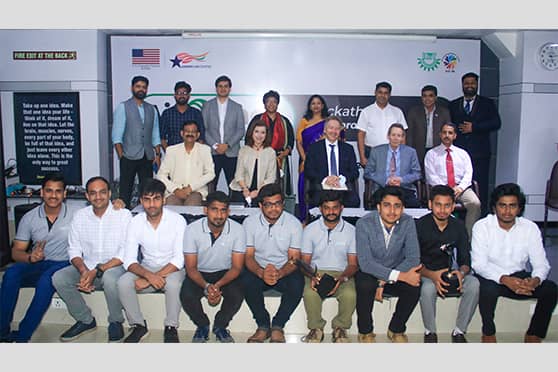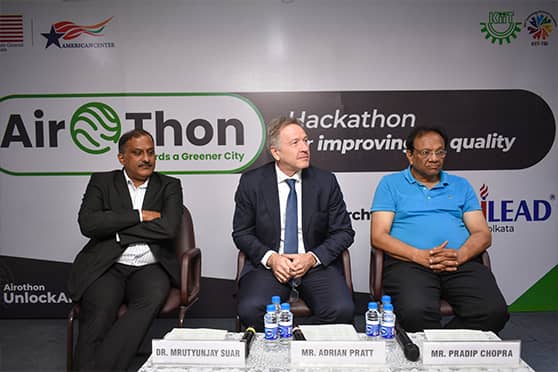IIT ISM Dhanbad, KIIT Bhubaneswar and Chandigarh University bag top places at Air-O-Thon


Over 60 students, researchers and faculty members came together to discuss the degrading air quality index at Air-O-Thon hosted by the US Consulate General, Kolkata, and Kalinga Institute of Information Technology-Technology Business Incubator (KIIT-TBI) at iLead College on March 30 and 31.
The 48-hour Air-O-Thon gave young minds a platform to come up with innovative, creative and sustainable solutions to air pollution in eastern and north-eastern India.
The team from Qualivon Technologies Private Limited, Berhampur, Odisha — K Pavan Kumar, Santosh Kumar Panda and Sandeep Battula — emerged as the winner for its business venture of manufacturing industrial emission monitoring equipment powered by nanotechnology.
Team DAFS — Om Sandilya, a first-year Mining Engineering student from Indian Institute of Technology (Indian School of Mining), Dhanbad; Harshit Mania, a first-year Computer Science Engineering student from KIIT, Bhubaneswar; and Granth Gaurav, a first-year Computer Science Engineering student from Chandigarh University; bagged the second position for presenting an indoor air purifier, which can reduce the concentration of toxic gasses in the air.
Team VpaC comprising second-year BTech Environmental Engineering students from Indian Institute of Technology (Indian School of Mining) Dhanbad — Aditya Singh Bhadauriya, Aditya Rathore, and Harshal Nahta was placed third. VpaC targeted pollutants caused by vehicular emissions through V-TENG (Vibrational triboelectric nanogenerator) technology.
Ideas were shortlisted across seven states — West Bengal, Odisha, Jharkhand, Bihar, Manipur, Assam, and Sikkim. The jury consisted of Vivek Kumar Rai, scientist; Tapan K. Gandhi, professor of Electrical and Biomedical Engineering, IIT Delhi and Dhrubajyoti Chattopadhyay, vice-chancellor, Sister Nivedita University, Kolkata.
The Air-O-Thon was inaugurated by Adrian Pratt, director, American Center, Kolkata. Also present at the event were Pradip Chopra, chairman, iLEAD; Mrutyunjay Suar, director-general, research and development, KIIT University; and Kankana Das, analyst and head of the east zonal office of Legal Initiative for Forest and Environment (LIFE).

“The US consulate general Kolkata, following the US Department of State, regularly engages with the local government, pollution control boards, policy makers, civil society members, students, youth leaders, media, think tanks, academic institutions, and other partners to work together and find ways to improve the air quality across eastern and north-eastern India. No country can solve the climate crisis alone. Everyone must do their part,” Pratt said.
The closing ceremony was attended by Gloria Berbena, minister counsellor for public affairs, US Embassy, New Delhi.
The top three teams will be offered mentorship and support to enhance their product technicalities and test for the next six months. The Pollution Control Board would then validate the concepts and if needed recommend them for large-scale implementations.
“We offered solutions for pollution caused by vehicular emission. We described briefly the working of our self-powered device, which works on the V-TENG (Vibrational triboelectric nanogenerator) technology. Also, we have a business plan that we want to implement in real-life situations and solve the air pollution problem. Two of our major learnings would be first, about business technicalities and second, alternative ideas about controlling and monitoring air pollution,” said Aditya Singh Bhadauriya, a student of IIT (ISM) Dhanbad and part of the second runner-up team.